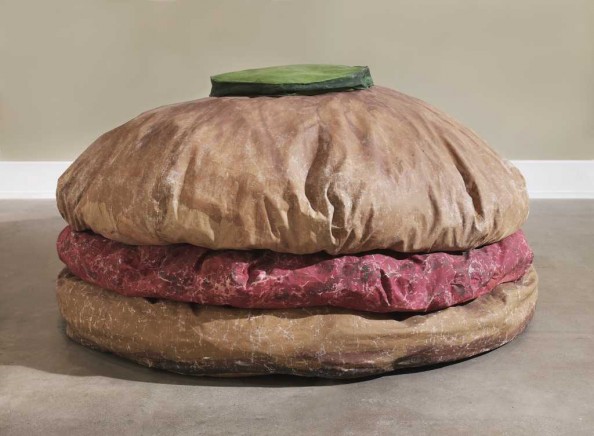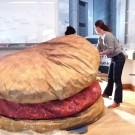“It’s a really big burger,” says AGO Contemporary and Inuit conservator Sherry Phillips with a grin. She’s explaining the delighted laughter of visitors who see her opposite the Henry Moore Sculpture Centre, busy restoring Claes Oldenburg’s Floor Burger.

Claes Oldenburg, Floor Burger (1962), canvas filled with foam rubber and cardboard boxes, painted with acrylic paint, 132.1 x 213.4, purchase, 1967, © 2012 Claes Oldenburg.
Sheer size is partly the reason the work is being done there, instead of upstairs in the Conservation Department, where space is limited. The sculpture is 7 feet in diameter. Spread out the two buns and the meat patty, plus pickle, plus tools — there’s be little room for any other projects.
The work is acrylic paint on canvas, stuffed with fist-sized chunks of polyurethane foam. Mostly foam, that is… There are also some squashed 1-quart ice cream cartons, and even crumpled pages from a St. Louis newspaper. (Surprise!)
The conservation focus is to stabilize the sculpture, especially its paint layers. Paint on canvas, stretched on a frame and hung on the wall, is inherently more stable than those same materials in a 3D soft sculpture. “Each time the piece is moved, the paint layers shift about.” Sherry points to the top bun. “See all the worn places? Those little flakes just pop off.”
 She has carefully harvested some tiny fragments, documenting each location, and prepared them for shipment to the Canadian Conservation Institute (CCI). By year’s end, she hopes to have their detailed report. It’s all part of the coherent, consistent body of documentation being created here and at MoMA (Museum of Modern Art) in New York, which has the two sister sculptures.
She has carefully harvested some tiny fragments, documenting each location, and prepared them for shipment to the Canadian Conservation Institute (CCI). By year’s end, she hopes to have their detailed report. It’s all part of the coherent, consistent body of documentation being created here and at MoMA (Museum of Modern Art) in New York, which has the two sister sculptures.
Now Sherry can devote herself to her other big fall task: consolidate the paint layers back to the canvas. This means, stroke by stroke, brushing an adhesive solution onto every damaged spot on each bun and the patty. (The pickle is in remarkable shape, and needs no help.)
While she’s busy doing that, she is also thinking about new and better ways to move the piece. Current front-runner: a strong, thin under-sheet, probably Tyvek, with straps and Velcro. “Then you could just slide the sculpture along, and position it as needed. Better than lifting it, less compression of the materials.”
Best-possible transportation is important because, early in 2013, the sculpture is off to MoMA to join Floor Cake and Floor Cone (also created in 1962, but after Floor Burger) in a spring retrospective.
And then? Once it’s home again, will it go on display? Not decided. Even getting it safely through our doors is a challenge, let alone finding space to exhibit it.
As Sherry says, it’s one big burger.